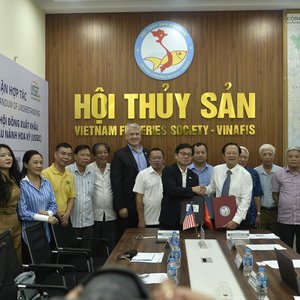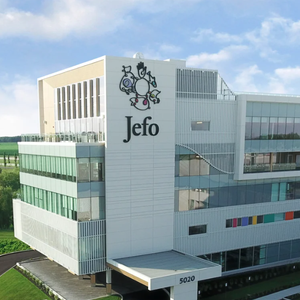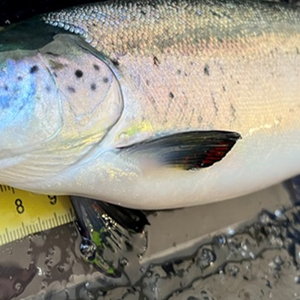Study to Lower Fishmeal in Yellowtail and White Seabass Diets
Addressing arguably the single greatest challenge facing the aquaculture industry, in March California Sea Grant researchers will begin development of low-fishmeal diets for yellowtail and white seabass – high-value species that aquaculture proponents believe would be top candidates for commercial offshore culture in Southern California and Baja California, Mexico, provided sustainable feeds for the carnivores become available.
“There is a worldwide (animal) protein shortage coming,” says grant recipient Rick Barrows, a fish nutritionist at the USDA’s Agricultural Research Service in Idaho. “There has been almost no increase in the amount of fishmeal harvested in about 20 years. Fishmeal is becoming very limiting.”
Barrows believes that marine aquaculture will price itself out of existence if industry does not devise novel ways of expanding its supply of affordable fish feed. Fish farmers are willing to pay more than poultry farmers for fishmeal, he says. But, at some point, aquaculture will compete with itself for fishmeal, and then prices will go sky high.
Chris Nelson, sales manager at Nelson and Sons, Inc./Silver Cup Fish Feed in Murray, Utah, agrees with the importance of resolving the feed issue. “Fishmeal is probably the highest input cost to farming fish. To make the industry sustainable, we have to be able to reduce the amount of fishmeal in diets. To be able to grow the industry, we must be able to reduce fishmeal in diets.”
The first goal of the Sea Grant project will be to identify optimal combinations of alternative protein sources from soy, canola, corn, barley, poultry-by-product meal and blood meal that may replace fishmeal without compromising fish health or growth.
To compensate for any nutritional deficits associated with using less fishmeal, scientists will also experiment with adding different mineral supplements to the protein mix. These “protein shakes” will be added to feeds at graded levels to progressively reduce fishmeal content.
Once appropriate protein sources, amino acid balances and mineral supplements are determined, scientists will conduct another round of experiments to optimize the feed’s protein to energy (calorie) content. They will then begin replacing fish oil with alternatives such as soy and canola oil and poultry fat.
The scientists hope to be able to cut fishmeal usage dramatically, and they point to the success in developing low-fishmeal Atlantic salmon diets as encouraging evidence of the project’s feasibility. “Marine fish feed currently contains about 45 percent fishmeal,” Barrows says. “We hope to get it down to about 10 or 15 percent. I think it is doable without reducing growth rates. That is what the experiments will show us.”
The fishmeal content of Atlantic salmon feed has been cut 75 to 80 percent, he says. But, marine fishes have different nutritional requirements than anadromous ones so there may be some added challenges. They just don’t know yet.
Neither yellowtail nor white seabass is commercially reared in California or Baja California, Mexico; however, both species are cultured regionally – white seabass in a commercial-sized hatchery in San Diego for stock enhancement and yellowtail in net pens in Baja California on an experimental basis.
Mexico does, though, already fatten wild-caught bluefin tuna in open-ocean net pens for the lucrative sushi market. Grant recipient Mark Drawbridge, the director of aquaculture at the Hubbs-SeaWorld Research Institute in San Diego, believes that commercial yellowtail production is on the horizon. “The tuna are getting harder to catch and they are smaller,” he says. “Mexico would like to diversify and either raise yellowtail side-by-side with the tuna or raise them instead of tuna.”
At issue is how to develop an industry that does not contribute to, or worsen, pressure on wild stocks. Jennifer Jacquet, a doctoral student at the University of British Columbia, Vancouver, who frequently gives talks on ocean sustainability issues, says that a third of the total fish biomass extracted from the world ocean annually is ground into fishmeal for poultry, hogs and farmed fish. To save the ocean from over harvesting, she and other environmentally minded scientists recommend, “eating like a pig.” That is they suggest people consume forage fishes such as sardines and anchovies directly, instead of eating the animals that have been raised on these species. The California legislature has also called for sustainable aquaculture practices, including minimizing the harvest of wild fishes for fishmeal due to concerns about marine ecosystem health.
Global warming is yet another reason for re-evaluating the human diet of the developed world, as, by some estimates, meat production now accounts for 20 percent of the planet’s greenhouse gas emissions.
“We think there will probably be multiple protein combinations that will be suitable for replacing fishmeal in yellowtail and white seabass diets,” Drawbridge says. “These will give farmers and feed producers flexibility to customize diets cost effectively.”
“We’ve been able to reduce fishmeal content in yellowtail by 50 percent just by substituting fishmeal with soybean meal,” Drawbridge says. The project was funded by the U.S. soybean industry.
“The problem is that soy, depending on the product used, can be expensive,” he says. A major goal of the project is to utilize waste products of poultry and seafood processing to keep feed costs low.
“People like to say that aquaculture is not sustainable because it takes fish to raise fish,” Barrow says. “But fish don’t require fish, they require nutrients. That is what this project will show.”










